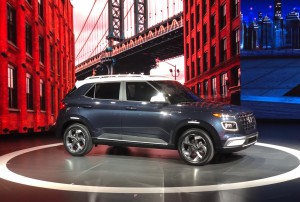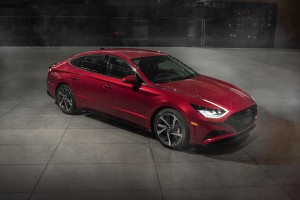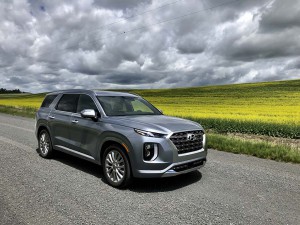Its been a busy year for Hyundai, the Korean carmaker launching 10 new or significantly updated models during just the last 12 months, and with more on the way. That includes bookends to its SUV line-up, the three-row Palisade just rolling into U.S. showrooms, and the pint-sized Venue set to debut later this year.
“Stretching the Hyundai brand” has been paying off, Brian Smith, the chief operating officer of U.S. operations said during a media drive of the new Palisade this week. While the overall American new vehicle market has stumbled 1.8% since the beginning of the year, Hyundai sales have climbed 1.7%. And while domestic retail sales are down 5%, Hyundai’s have increased by 5%.
The rapid expansion of Hyundai’s SUV line-up has clearly helped it regain momentum after several years of decline, but it also hasn’t hurt that the automaker’s traditional image, that of a bargain-basement brand selling vehicles of questionable quality, is fading away, said COO Smith. That was underscored by the fact that Hyundai came in third on the 2019 J.D. Power Initial Quality Survey, behind only Genesis, the luxury brand it spun off several years ago, and sibling Kia.
With the coming Venue and the new Palisade, Hyundai will have a “full nest” of SUVs said Smith, a total of seven offerings that cover all but the biggest segments of the utility vehicle market. That’s up from just three utility vehicles a couple years ago.
(Germans, Japanese struggle as Koreans expand lead in Power Initial Quality Study. Click Here for more.)
The Palisade, in particular, could take motorists by surprise, especially if they haven’t been following the changes the automaker has undergone. The top-line Limited trim, in particular, features the sort of high-line details and features more typically found on a near-luxury brand like Buick or Volvo – though the Palisade Limited also carries a price tag starting in the mid-$40,000 range that could also surprise traditional Hyundai buyers.
The company hasn’t walked away from its original base, however. The Venue, set to debut later this year, will provide an entry point into that expanded crossover line-up, the subcompact model replacing the old Accent hatchback.

The Hyundai Venue made its debut in New York earlier this year and now gives the brand a competitor in every SUV segment, but one.
Nonetheless, the move up-market with products like Palisade have added several thousand dollars to the average Hyundai transaction price. But consumers seem to welcome the new strategy. Not only has Hyundai posted 10 consecutive months of year-over-year sales gains, but also it has seen its incentives drop by 87% since May 2018.
The company is hoping that it can retain that momentum by picking up volume in key markets were it either didn’t previously play or where it lagged key competitors. Family buyers make up just a 16.2% share of its overall sales right now, compared to 21.3% for Chevrolet and 23.5% for Mazda, according to Hyundai data. With the three-row Palisade replacing the smaller Santa Fe XL, that is one of the areas where the Korean brand sees strong opportunities.
Hyundai admittedly was slow to respond to what has become the most dramatic shift in the U.S. market in decades, light trucks, overall, accounting for more than two-thirds of current new vehicle sales. Before it began adding new models, such as the Kona, SUVs accounted for less than 40% of Hyundai’s American volume. In May, noted Smith, that “was approaching 55%,” well ahead of the original target of 50% by the end of 2019.
(Click Here for more about our first drive in the 2019 Hyundai Santa Fe Ultimate.)
Longer-term, Smith expects utility vehicles to reach about 60% of its U.S. volume. That would lag a bit behind the overall light truck share of the U.S. market, but Hyundai doesn’t compete in several key segments, such as the full-size SUV market dominated by the likes of the Chevrolet Suburban. It also has no pickup truck in the line-up, though the company continues to work on a production version of the popular Santa Cruz concept. It could reach U.S. showrooms by early in the coming decade, executives have suggested in recent months.

Hyundai has expanded its SUV line-up, but not at the expense of what was its bread-and-butter products — sedans, like the 2020 Sonata.
Despite the flood of new crossovers, “We’re not exiting the sedan market,” said Mike O’Brien, Hyundai Motor America’s chief product planner. “We have new sedans coming” to take advantage of what he called “a lot of loyalty in that area” from existing owners of models like the Sonata and Elantra.
O’Brien also said he sees a strong possibility that younger buyers, who have been moving back to urban centers at a rate unseen in decades, may be more open to sedans than older generations. That point was echoed by a new study released by Edelman Intelligencer this past week.
One of the big decisions Hyundai will have to make in the coming months is where and how to produce all the new products for the U.S. market. It currently operates one American assembly plant, though it has traditionally shared some of the capacity of its sibling, Kia. The larger of the Korean brands may need to expand American capacity, as officials are looking at localizing production of several models. In particular, it would likely need to do that with a production version of the Santa Cruz to avoid the “chicken tax” of 25% on imported pickups.
(Nissan cites new study, predicts sedans may be in for a comeback. Click Here for the story.)
But such a decision, officials said during a news conference at the Palisade launch, is still months away.

